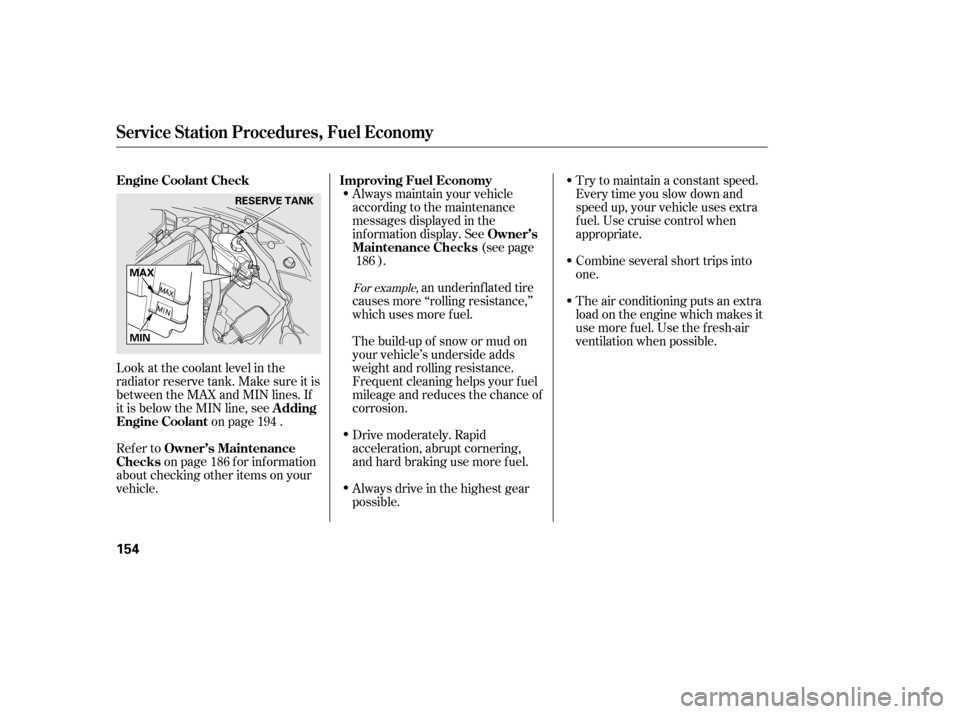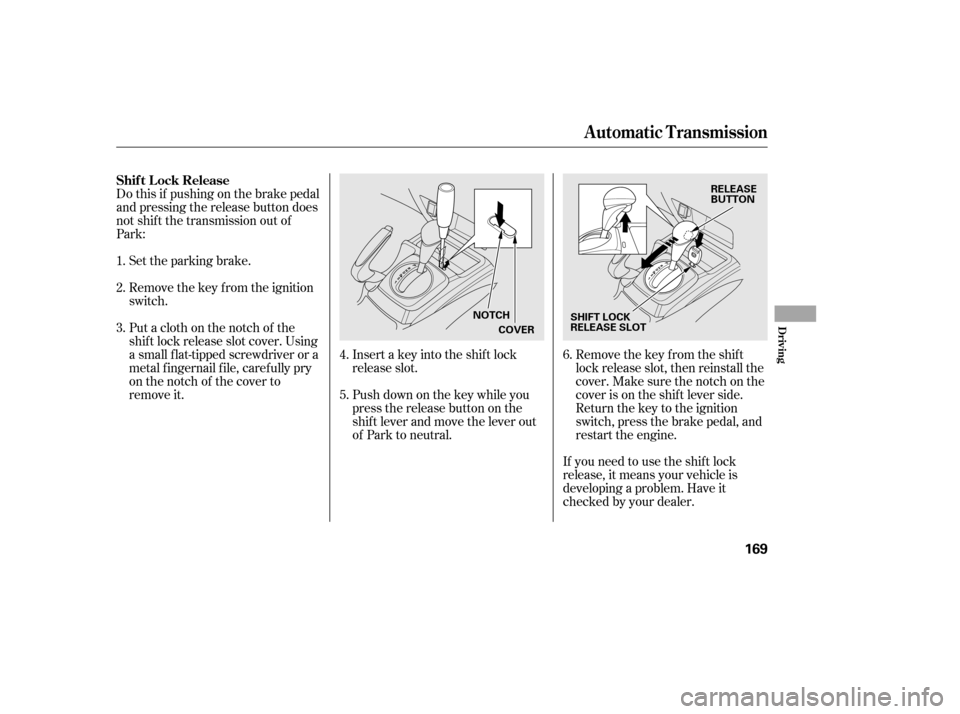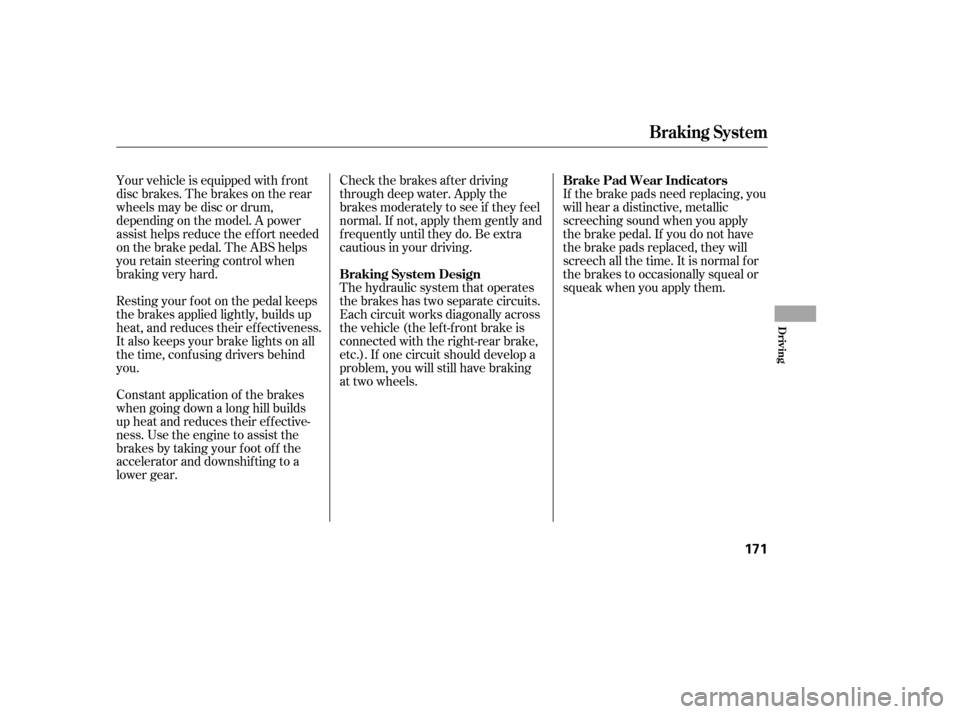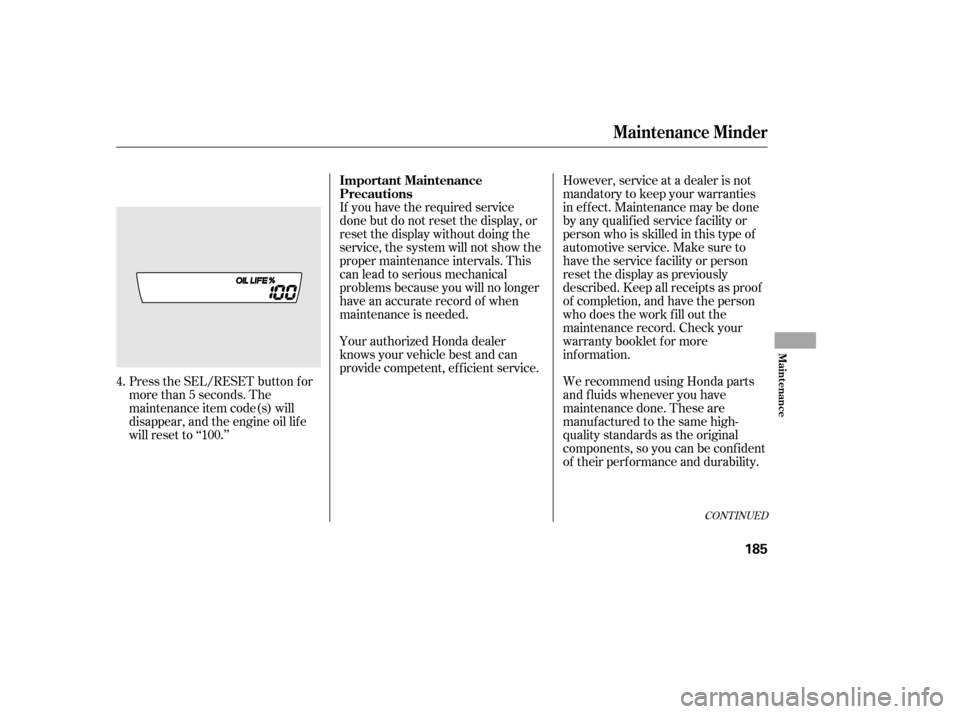Page 145 of 253

If the hood latch handle moves
stif f ly, or if you can open the hood
without lifting the handle, the
mechanism should be cleaned and
lubricated.
Put your f ingers under the f ront
edge of the hood near the center.
Slide your hand to the lef t until
you f eel the hood latch handle.
Push this handle up to release it.
Lif t up the hood.
Push the f uel f ill door closed until
it latches.
Screw the fuel fill cap back on
until it clicks at least once. If you
do not properly tighten the cap,
the malf unction indicator lamp
maycomeon(seepage ).You
will also see a ‘‘CHECK FUEL
CAP’’ message on the inf ormation
display.
Park the vehicle, and set the
parking brake. Pull the hood
release handle under the lower lef t
corner of the dashboard. The
hood will pop up slightly.Holding the grip (the rod can be
hot if the engine has been
running), pull the support rod out
of its clip. Insert the end into the
designated hole in the hood.
2.
1.
3.
5. 6.
230
Service Station Procedures
Opening and Closing the Hood
152
HOOD
RELEASE
HANDLE
LATCH
�����—�����—�����y�
�������������y���
�(�#���������y���
�����y
Page 146 of 253
Remove the dipstick again, and
check the level. It should be
between the upper and lower
marks.
Wait a f ew minutes af ter turning the
engine of f bef ore you check the oil.
Remove the dipstick (orange loop).
Wipe the dipstick with a clean
cloth or paper towel.
Insert it all the way back in its tube.
To close the hood, lif t it up slightly to
remove the support rod f rom the
hole. Put the support rod back into
its holding clip. Lower the hood to
about a f oot (30 cm) above the
f ender, then let it drop. Make sure it
is securely latched.
If it is near or below the lower mark,
see on page .
2. 3.
1.
4.
191
Service Station Procedures
Oil Check
A dding Engine Oil
Bef ore Driving
153
DIPSTICK UPPER MARK
LOWER MARK
SUPPORT ROD
CLIP GRIP
�����—�����—�����y�
�
�����������y���
�(�#���������y���
�����y
Page 147 of 253

Try to maintain a constant speed.
Everytimeyouslowdownand
speed up, your vehicle uses extra
f uel. Use cruise control when
appropriate.
Combine several short trips into
one.
The air conditioning puts an extra
load on the engine which makes it
usemorefuel.Usethefresh-air
ventilation when possible.
Always maintain your vehicle
according to the maintenance
messages displayed in the
inf ormation display. See
(see page
).
Always drive in the highest gear
possible.
Drive moderately. Rapid
acceleration, abrupt cornering,
and hard braking use more f uel.
The build-up of snow or mud on
your vehicle’s underside adds
weight and rolling resistance.
Frequent cleaning helps your f uel
mileage and reduces the chance of
corrosion. an underinf lated tire
causes more ‘‘rolling resistance,’’
which uses more f uel.
Look at the coolant level in the
radiator reserve tank. Make sure it is
between the MAX and MIN lines. If
it is below the MIN line, see on page .
Refer to on page f or inf ormation
about checking other items on your
vehicle. 194
186 186
For example,
Improving Fuel Economy
Engine Coolant Check
Owner’s
Maintenance Checks
A dding
Engine Coolant
Owner’s Maintenance
Checks
Service Station Procedures, Fuel Economy
154
RESERVE TANK
MIN
MAX
�����—�����—�����y�
�������������y���
�(�#���������y���
�����y
Page 154 of 253
Make sure all windows, mirrors,
and outside lights are clean and
unobstructed. Remove f rost, snow,
or ice.
Check that the hood and trunk are
f ully closed.Check that any items you may be
carrying are stored properly or
f astened down securely.
Check the seat adjustment (see
page ).
Check the adjustment of the
inside and outside mirrors (see
page ).
Check the steering wheel
adjustment (see page ).
Make sure the doors are securely
closed and locked.Fasten your seat belt. Check that
your passengers have f astened
their seat belts (see page ).
Youshoulddothefollowingchecks
and adjustments every day bef ore
you drive your vehicle.
When you start the engine, check
the gauges and indicators in the
instrument panel (see page ).
Visually check the tires. If a tire
looks low, use a gauge to check its
pressure (see page ).
1. 2. 3. 4.
9.
8.
7.
6.
5.
10.
88
96 73 16
59
209
Preparing to Drive
162
�����—�����—�����y�
�������������y���
�(�#���������y���
�����y
Page 161 of 253

Do this if pushing on the brake pedal
and pressing the release button does
not shif t the transmission out of
Park:Set the parking brake.
Remove the key from the ignition
switch.
Insert a key into the shift lock
release slot.
Push down on the key while you
pressthereleasebuttononthe
shif t lever and move the lever out
of Park to neutral.Remove the key from the shift
lock release slot, then reinstall the
cover. Make sure the notch on the
cover is on the shif t lever side.
Return the key to the ignition
switch, press the brake pedal, and
restart the engine.
If you need to use the shif t lock
release, it means your vehicle is
developing a problem. Have it
checked by your dealer.
Putaclothonthenotchof the
shif t lock release slot cover. Using
a small f lat-tipped screwdriver or a
metal f ingernail f ile, caref ully pry
on the notch of the cover to
remove it.
1. 2. 3.
4.5.6.
Shif t L ock Release
Automatic Transmission
Driving
169
COVER
RELEASE
BUTTON
SHIFT LOCK
RELEASE SLOT
NOTCH
�����—�����—�����y�
�
�������
���y���
�(�#���������y���
�����y
Page 163 of 253

Check the brakes after driving
through deep water. Apply the
brakes moderately to see if they f eel
normal. If not, apply them gently and
f requently until they do. Be extra
cautious in your driving.
Resting your f oot on the pedal keeps
the brakes applied lightly, builds up
heat, and reduces their ef f ectiveness.
It also keeps your brake lights on all
the time, conf using drivers behind
you.
Constant application of the brakes
when going down a long hill builds
up heat and reduces their ef f ective-
ness. Use the engine to assist the
brakes by taking your f oot of f the
accelerator and downshif ting to a
lower gear. The hydraulic system that operates
the brakes has two separate circuits.
Each circuit works diagonally across
the vehicle (the lef t-f ront brake is
connected with the right-rear brake,
etc.). If one circuit should develop a
problem, you will still have braking
at two wheels.If the brake pads need replacing, you
will hear a distinctive, metallic
screeching sound when you apply
the brake pedal. If you do not have
the brake pads replaced, they will
screech all the time. It is normal f or
the brakes to occasionally squeal or
squeak when you apply them.
Your vehicle is equipped with f ront
disc brakes. The brakes on the rear
wheels may be disc or drum,
depending on the model. A power
assist helps reduce the ef f ort needed
on the brake pedal. The ABS helps
you retain steering control when
braking very hard.
Braking System DesignBrake Pad Wear Indicators
Braking System
Driving
171
�����—�����—�����y�
�������������y���
�(�#���������y���
�����y
Page 165 of 253

Your vehicle has been designed to
primarily carry passengers and their
cargo. You can also use it to tow a
trailer if you caref ully observe the
load limits, use the proper equipment,
and f ollow the guidelines in this
section.The
maximum allowable weight of the
trailerandeverthinginoronitmust
not exceed 1,000 lbs (450 kg).
Towing a load that is too heavy can
seriously af f ect your vehicle’s
handling and perf ormance. It can
also damage the engine and
drivetrain. Theweightthatthe
tongue of a f ully-loaded trailer puts
on the hitch should be approximately
10 percent of the total trailer weight.
Too much tongue load reduces f ront-
tire traction and steering control.
Too little tongue load can make the
trailer unstable and cause it to sway.
CONT INUED
Towing a Trailer
Load Limits
T otal T railer Weight: T ongue L oad:
Driving
173
Exceeding any load limit or
improperly loading your vehicle
and trailer can cause a crash in
which you can be seriously hurt
or killed.
Check the loading of your
vehicle and trailer carefully
beforestartingtodrive.
�����—�����—�����y�
�����������
�y���
�(�#���������y���
�����y
Page 176 of 253

Press the SEL/RESET button f or
more than 5 seconds. The
maintenance item code(s) will
disappear, and the engine oil lif e
will reset to ‘‘100.’’If you have the required service
done but do not reset the display, or
reset the display without doing the
service, the system will not show the
proper maintenance intervals. This
canleadtoseriousmechanical
problems because you will no longer
have an accurate record of when
maintenance is needed.
Your authorized Honda dealer
knows your vehicle best and can
provide competent, ef f icient service.
However, service at a dealer is not
mandatory to keep your warranties
in effect. Maintenance may be done
by any qualif ied service f acility or
person who is skilled in this type of
automotive service. Make sure to
have the service f acility or person
reset the display as previously
described. Keep all receipts as proof
of completion, and have the person
who does the work fill out the
maintenance record. Check your
warranty booklet f or more
inf ormation.
We recommend using Honda parts
and fluids whenever you have
maintenance done. These are
manuf actured to the same high-
quality standards as the original
components, so you can be conf ident
of their performance and durability.
4.
CONT INUED
Maintenance Minder
Important Maintenance
Precautions
Maint enance
185
�����—�����—�����y�
������
������y���
�(�#���������y���
�����y